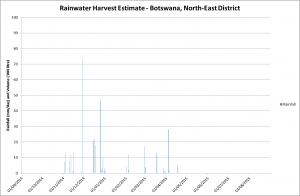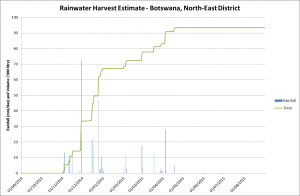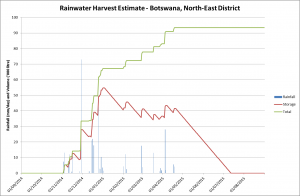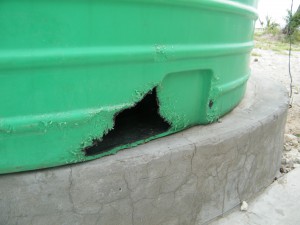With water shortages being in the news for the last few years the question of “Why can’t we catch this water and use it?” pops up on Botswana Twitter.
One of the popular solutions, and frequently implemented on government staff houses in rural areas, is to put gutters on houses and direct the collected rainwater into plastic water tanks. Seems like a great idea, but how do the numbers add up?
I did a few calculations using data from our weather station for the 2014-2015 period and it is interesting, with different answers depending on circumstances (no surprise there, then).We had 360mm of rain that season, falling on 32 days between 3 November 2014 and 18 April 2015.

Our roof is 260m².
0.360m x 260m² = 94m³ or 94,000 litres

Sounds like a lot of water? Well, we use between 200l and 400l per day on average for the garden (currently recycled grey water from the house).
That means a full 10,000l tank will last about a month, but we just calculated that in a year we get 9 tanks worth of water so why not buy 9 tanks?
The answer is that the 94,000l doesn’t arrive in one lump, as can be seen in the previous chart it accumulates over about 6 months, with up to a month between rainfall events. During the dry spells we will be drawing down the level in the tanks.

All we need then are 5 x 10,000l tanks and we will be saving about 90,000 litres of water per year. Glorious! Let me rush out and do my bit to save the planet.
Except when you get to the builders’ merchant you’ll find those tanks are P10,000 each… that’s an investment of P50,000 before allowing for the necessary plumbing.
Water Utilities Corporation sell us water at P11.50 per 1,000 litres (Francistown area, 15,000l-25000l/month). P11.50/l x 90,000l / 1,000 = P1,035 per year.
Using a simple return on investment calculation of P50,000 (capital) / P1,035/yr = 48yr ROI.
Sorry environment, I can’t afford that.
As such, for our situation it makes more sense to design a low-water garden and continue recycling our grey water which is produced daily.
In a rural location without reticulated water (and pit latrine rather than flush toilet) then harvesting makes sense, as a single 10,000l tank might provide water for 100 days or more. The ROI calculation in this instance becomes more favourable as the actual cost of collecting and transporting water daily or weekly (as is common) is a direct saving to the consumer. Although water collection is often not a cash cost (sending children with a wheelbarrow or donkey cart to the standpipe is common) the benefits of the additional time available for studying and other tasks is a benefit to the family.
Putting 100l/day into the spreadsheet and tuning the roof size to maximise use gives the following:

To get maximum use you need a roof area of 50m² per tank, say 7m x 7m.
Which is great until a porcupine eats the water tank.

Disclaimer: rainfall amounts vary depending on year and region, intense rainfall events are often limited to a relatively small area.
If you’ve read this far I’m interested in a bit of help for another post on my to-do list: I need a contour map of Gaborone. I’ve located some possibly useful level data but I don’t currently have time to learn how to process it and turn it into a usable map. Google has so far failed me – I can get spot heights from Google Earth but it’s a clunky way to work.